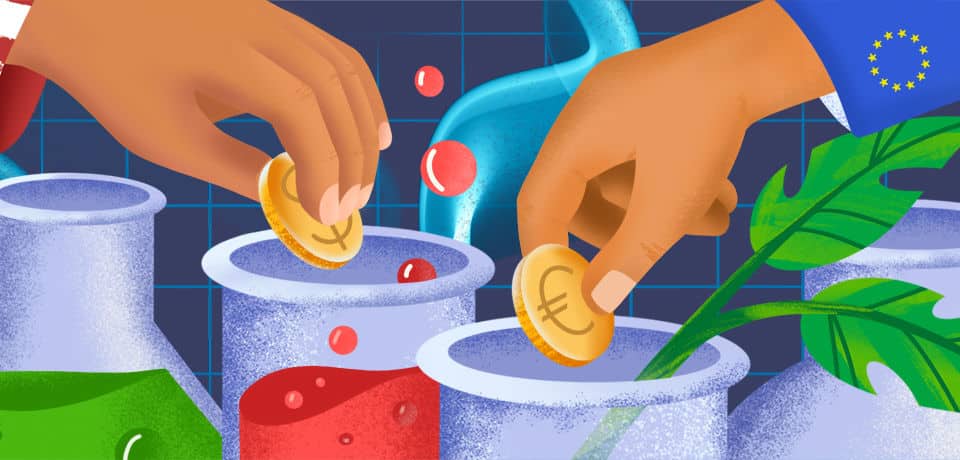The year 2021 is closing with a biotech investment rush as Eir Ventures, Apollo Health Ventures, and Merck’s venture capital arm M Ventures raise impressive funds to speed up life sciences innovation.
This year is set to break records in terms of the money flowing into institutional life science investors. With 2021 not even finished, European biotech investors have bagged over €9B. This vastly outperforms the €4.5B total in 2020 — which was itself a record-breaking year for biotech investments.
Just this month, the US-German investment firm Apollo Health Ventures dedicated a €159M ($180M) fund to companies slowing the aging process. And this week, Eir Ventures closed its Nordic biotech-focused fund at €122M while Merck KGaA announced plans to pump €600M into its corporate venture capital (VC) arm M Ventures. The German big pharma offshoot invests in companies developing medicines and tools to treat diseases in addition to companies in the tech sector.
According to Rafaèle Tordjman, Founder and CEO of the French firm Jeito Capital, this upwards trend is “one of the consequences of the Covid-19 crisis, which has raised awareness of the central role played by the biotech industry in solving the pandemic, and therefore the need to invest significantly in this capital-intensive industry.”
In September, Jeito closed its first fund at €534M, and a month later, compatriot investment firm Sofinnova Partners raked in €472M. Last month, LSP in the Netherlands raised its biggest-ever fund with €850M. This boom for life sciences investment firms seems to be unaffected by an ongoing gloom in public biotech stocks.
“We’re seeing the entire sector shift and are able to access funds we never would have dreamed of accessing before,” said Antoine Papiernik, Sofinnova’s Managing Partner and Chairman.
“Healthcare and biotech – while once considered slightly risky investments in Europe – are now very much a priority for even the most conservative investors. Everyone wants to make sure they are in it and that has led to a strong increase in VC funding.”
The average size of these funds also seems to be increasing, and Sander Slootweg, the Managing Partner of Forbion, sees them gathering even more momentum forward.
“There is a trend of consolidation of the VC industry where the bigger funds get bigger and increase their offering to their investors and the smaller funds struggle to raise subsequent funds,” he explained. “This has to do with a critical mass of people and skills on the teams, market reach, and increased regulatory hurdles for VC funds.”
The bulk of funding for European life sciences investors is earmarked for companies developing disease treatments. Nevertheless, industrial biotech companies stand to gain from recent closings by Sofinnova and the European Circular Bioeconomy Fund. And other big money pots raised by firms including the Swedish firm Segulah Medical Acceleration place emphasis on the thriving fields of medtech, diagnostics, and genomics.
One reason for the ballooning interest in European life sciences is that biopharma and medtech companies are maturing fast in this region. Additionally, many European firms such as the vaccine developers BioNTech and CureVac have gained huge publicity in the fight against the Covid-19 pandemic.
“Europe is now on par with the US in terms of technology,” said Papiernik. “When you think about the biotech companies that have played the most critical roles in confronting and beating this global healthcare crisis, you think both of BioNTech and Moderna.”
A number of the funds focus on plugging gaps in support for late-stage biotech companies in Europe. However, other investors see the need for more money at the early stages of the biotech life cycle.
“We should not underestimate how critical seed funding is,” said Alain Huriez, Chairman and Managing Partner at Advent France Biotechnology. “Early funding conducted by professional investors with previous operational experience is essential in building up a young, strong, and healthy ecosystem.”
The European biotech ecosystem has a big strength that is attracting investments to the continent: European companies often provide investors more bang for their buck than their US counterparts.
“Europe is seen as very attractive currently because good quality assets can be sourced 40% cheaper compared to equivalent US assets and the cost of running a biotech business in Europe is 50% lower compared to the US,” said Slootweg.
As we move further into 2022, it’s likely that the wave of funding fuelling European biotech investors is going to get bigger.
“I think this trend will continue: the market for therapeutic innovation is not a bubble, especially when we know that there are currently no effective treatments for approximately 75% of the diseases known today worldwide,” said Tjordman.
“I am therefore really optimistic about the future trends of VC fundraising in life sciences.”





